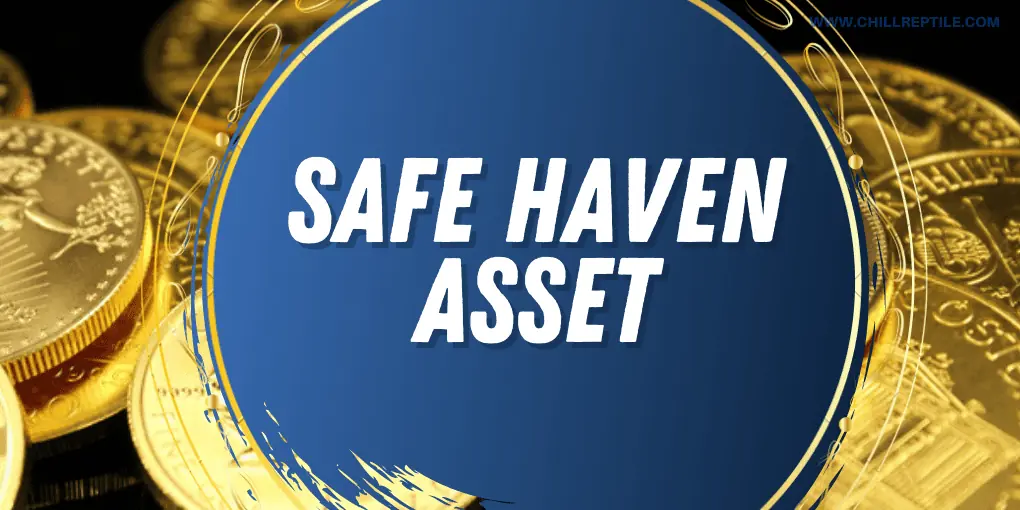Markets crash. Economies wobble. But you, you can stand firm. Put simply, when global troubles stir, Safe-Haven Assets in Times of Crisis are your anchors. These are the investments that offer peace of mind when others are panicking. Grab your financial flashlight; it’s time to explore the assets that can help you navigate through the stormy markets. With gold’s shine and bonds’ shield, you’ll get to know your crisis survival kit right here. Let me guide you to those dependable treasures that can protect your hard-earned cash when the economic seas get rough.
Understanding Safe-Haven Assets in Market Turmoil
Gold: The Quintessential Safe Haven
When markets shake, gold stands firm. It’s often your best pal in rough times. People flock to gold during turmoil. Why do folks trust gold when things get tough? It holds value when cash may not. For ages, gold has offered this steady hand.
We love gold for its lasting worth. Gold investing during recessions is a smart move. It’s like an anchor in stormy financial seas. Imagine a boat that stays still while waves crash. That’s gold for your investments. Add it to your stash, and sleep better at night.
Gold comes in bars, coins, or even jewelry. Each piece you own is a slice of security. Studies say gold often beats inflation. This means as costs rise, so can your gold’s value. It’s a shield against losing money power.
It’s no secret gold shines when stocks drop. Say stocks take a dive; gold often climbs. This is why it’s precious metals stability we talk about. It’s not just pretty – it’s powerful.
The Defensive Nature of US Treasury Bonds
US Treasury bonds are a snug safety net. Think of them as a promise from Uncle Sam. You lend cash; the government vows to pay back. It’s a pledge that stands strong, even in bad times.
Why are Treasury bonds a good choice when scared? They’re known to hold up when other bets may fail. As markets dive, these bonds often soar. It’s like having a parachute when your plane is in trouble.
These bonds come with a happy bonus. The interest they pay comes twice a year. So, you earn while you shield your bucks.
But wait, what if prices skyrocket? Good news – some bonds protect you from inflation. They adjust as living costs change. This makes them inflation protection assets. Your money stays mighty, whatever the cost of bread.
Treasury bonds also help with portfolio risk management. They add balance. When stocks zig, bonds often zag. This mix can smooth out the ride in bumpy times.
What’s more, buying government debt is seen as safe. Countries rarely fail to pay their loans. This fact makes them a surefire bet in chaos.
So, let’s wrap up. In choppy financial waters, safe havens matter most. While gold is your sturdy shield, Treasury bonds are your steady promise. Together, they help keep your boat afloat. Hold them tight, and weather any storm.
Strategic Asset Diversification During Economic Uncertainty
Currency Diversification: More than Just Forex
When money gets tight, smart folks look for the best ways to keep their cash safe. You’ve heard of “don’t put all your eggs in one basket,” right? That’s what currency diversification is about. Do more than just trade money on forex. Build a safety net with different kinds of money from around our world. For instance, the Swiss Franc and Japanese Yen are like life vests in a sea of unrest. They float even when others sink.
What makes these currencies strong? Well, both countries have low debt and strong economies. That’s why folks trust them in hard times. This isn’t just about having foreign bills in your pocket. It’s a real strategy to make sure you’re protected. Let’s say your country’s money loses value because times are tough. If you have cash in one of these sturdy currencies, you’re not out of luck.
When it comes to keeping your wallet risk-free, think of these moneys as a calm port in a storm. They help when the financial market rocks and rolls. But remember, no one choice is perfect. It’s about mixing different types to guard your money better.
Real Estate and Commodities: Weighing Pros and Cons
Now let’s turn to stuff you can touch—like houses and metals. Real estate and commodities like gold often shine when stocks crash. Why do they stand strong? Because people always need a place to stay and goods to get by. The trick is knowing when and what to buy.
In good times, owning a house or apartment can be a moneymaker. When markets get wild, they can be a safe spot to hide your dough. But timing is key. Real estate isn’t quick to sell, and its value won’t jump fast. So, pick it for the long game, not for a quick buck.
Gold is a star player when folks worry about cash losing its worth. It’s like a secret fort—keeping its cool when inflation attacks. Why trust gold? It’s been a treasure for ages and people flock to it when they’re scared. The price can sure swing, but it holds its ground in storms.
Yet, just like a coin has two sides, these assets have their downs and ups. Real estate takes a ton of cash to start, and it’s not easy to turn back into cash fast. And while gold glows in trouble, it may not race ahead like stocks in sunny times.
So, when you stare down the beast of market ups and downs, think about adding these to your toolkit. They may not win the race quick, but they can help you stay the course. Remember, though, it’s about balance. Mix them with other smart choices, like stocks that sell stuff we always need, no matter what.
Risk whispers in every corner of the market, but with a steady mind and a strong mix of assets, you can weather the storm. Keep your eyes wide, your heart steady, and diversify. It’s your best bet for a shield against the unknown.
Portfolio Risk Management with Non-Traditional Investments
Cryptocurrency: A New Age of Crisis-Resistant Investments?
Let’s talk about money, but not the kind in your wallet. Have you ever heard of cryptocurrency? It’s like money, but online. People like it when the economy gets tough. In an economic downturn, many folks wonder, “Can cryptocurrency actually help?” The short answer: yes, it can. It is similar to hiding a “digital gold” under your mattress, only safer.
Now, let’s dig deeper. During bad times, regular money might lose value. This is a real scare for your piggy bank. But, here’s where cryptocurrency shines. It isn’t tied to any one country’s money. So if one country’s economy trips, the crypto might skip without a scratch.
Cryptocurrencies sort of act like a boat with lots of air pockets. Even if water gets in, it doesn’t sink. I’ve seen it sail through the 2008 recession, dodging the worst crashes. It’s not a sure thing, though. It can be as rocky as a roller coaster. So, just a little bit might be enough for your crisis kit.
Silver and Art: Valuable Assets Beyond the Norm
When people get nervous about markets and money, they look for safe spots. Silver and art are two cool spots to look at. You might think, “Silver? Why not gold?” Silver’s like the little brother to gold. It costs less and is easier to buy. And it’s handy. Industries need it, from solar panels to phones. So its value might stay solid, even when the financial market uncertainty hits the fan.
Now let’s get creative and talk about art. Art isn’t just to make your walls look nice. It can be a sneaky good way to keep your money safe. Why? Because no matter what, people find art special. It can keep its value or even get more valuable, even when the world is flipping upside down.
But remember, art and silver aren’t quick money grabs. They’re like old trees: growing value takes time. Also, they need safe keeping. You can’t just stuff them under a bed. Silver needs a safe spot so it doesn’t rust. And art? Well, it wants no sun or rain dance, just a cozy room.
Keeping art and silver is as much about being smart as it is about liking shiny and pretty things. They’re strong players for your team in the scary game of financial market uncertainty. Just like a superhero team, your investments should have a mix of powers. Some to fight now, some to save the day later.
So there you have it! Cryptocurrency, silver, and art. They may not be your regular team players, but when the going gets tough, these guys can help protect your hard-earned cash like sturdy shields in a financial battle.
Proactive Investment Strategies for Recession-Proofing
Patronizing Blue-Chip Stocks and Consumer Staples
When crisis hits, we scramble for safety. Think of blue-chip stocks as your financial bunker. These are stocks from big, strong companies. They’ve been around the block. They can take a hit and keep going. Their power lies in trusted names, solid histories, and steady money-making. Even when markets freak out, these giants often stand tall.
So, blue-chip stocks? Yes, they are a safety net. They often pay dividends, which means you get cash just for holding them. And they’re like that wise friend who’s calm in a storm. Think of household brands, your soap, and bread makers. They sell things people always need, no matter the economic weather. We call them consumer staples. They’re as close as we get to a sure thing in the stock world.
Incorporating Hedging Strategies Using Safe-Haven Assets
Now, let’s talk defense. When playing in the rough financial market, you need a shield. Hedging strategies are just that. They’re like insurance for your money. Safe-haven assets shine here. We’re talking gold, US Treasury bonds, and sometimes even cash itself. These assets can zig when markets zag.
Gold has been a go-to in scary times. It’s been around forever, and people trust it. The beauty of gold? It doesn’t move with stocks or bonds. When other things tank, it can rise. Next up, US Treasury bonds. They’re backed by the US government, making them super safe. People buy them when everything else looks too risky.
Crisis time means we also value cash high. Having cash helps you stay afloat. It lets you buy assets when they’re cheap, like a sale during market panic. Then there’s silver, not as famous as gold, but it’s a tiny warrior in your portfolio.
Foreign exchange can be your sneaky play. In messes, the Swiss Franc and Japanese Yen often do well. They come from strong economies with big foreign exchange reserves. So, money moves there when the world looks shaky.
Let’s not forget real estate. Owning real land or buildings can be smart. They’re real things that can be rented out or sold later. But be careful; they’re not quick to cash out, and prices swing.
Hedging means not putting all your eggs in one basket. Mix assets to cover each other’s backs. When something falls, something else keeps you steady. That’s the core of hedge thinking. Use solid things like precious metals or government bonds paired with strong company stocks.
It’s like a game of chess with your future. You have to think ahead, move smart, and always have a protection plan. As your crisis survival kit, blue-chip stocks and hedging with safe assets are vital moves. With them, you can sleep better, knowing you’ve built a fortress around your money.
We’ve taken a good look at how to keep your money safe when the market goes wild. From classic choices like gold to newer picks like cryptocurrency, we have options. Gold remains a top pick for most, and U.S. Treasury Bonds are as steady as they come. We also talked about ways to mix it up with different kinds of money, real estate, and goods, always weighing the good against the bad.
Then, we jumped into other ways to protect our cash with things not everyone thinks about, like silver and art. Don’t forget blue-chip stocks and daily needs, either. They’re like the steady hands that keep your investments from falling apart. Plus, smart moves like hedging give you a safety net.
I think when money feels like a wild ride, the smartest move is to be ready for anything. Choose wisely, mix it up and always have a plan. That’s how you ride out the storms without losing sleep. Your future self will thank you for being so sharp.
Q&A :
What are safe-haven assets and why are they important during a crisis?
Safe-haven assets are financial instruments that investors flock to in times of uncertainty or economic downturn. They are considered important during a crisis because they tend to retain or increase in value while other assets may be losing value, thus providing a measure of financial protection.
How do safe-haven assets perform in comparison to other investments during market volatility?
During market volatility, safe-haven assets usually perform better than more speculative investments. While equities and high-yield bonds might experience significant price swings, safe-havens such as gold, U.S. Treasury bonds, or certain currencies like the Japanese yen or Swiss franc are likely to remain stable or appreciate.
Can cryptocurrencies be considered as safe-haven assets?
The characterization of cryptocurrencies as safe-haven assets is a topic of debate among investors. Some argue that certain cryptocurrencies, like Bitcoin, have properties of safe-haven assets due to their limited supply and independence from traditional financial systems. However, their historically high volatility can detract from their safe-haven status.
What are some common strategies for incorporating safe-haven assets into an investment portfolio?
Common strategies for incorporating safe-haven assets into an investment portfolio include diversification, where a portion of the portfolio is allocated to these assets, and tactical asset allocation, which involves adjusting the balance of safe-haven assets based on current economic indicators or market conditions.
Are there any risks associated with investing in safe-haven assets?
While considered low risk, especially in times of crisis, safe-haven assets are not entirely without risk. They may provide lower returns compared to equities during market rallies, and their value can be influenced by various factors such as changes in interest rates or investor sentiment. It’s vital for investors to consider these risks and their overall investment strategy.






